Catastrophic dangers and impacts?
Yes, even according to the IPCC.
While scientists in general seldom talk of catastrophic climate change, there is one section in the IPCC where the risk of catastrophes to the planet and to human populations are confirmed.
IPCC 4th Assessment 2007 2.2.4 Risk of catastrophic or abrupt change
The possibility of abrupt climate change and/or abrupt changes in the earth system triggered by climate change, with potentially catastrophic consequences, cannot be ruled out (Meehl et al., 2007).
Disintegration of the West Antarctic Ice Sheet (See Meehl et al., 2007), if it occurred, could raise sea level by 4-6 metres over several centuries. A shutdown of the North Atlantic Thermohaline Circulation (See Meehl et al., 2007) could have far-reaching, adverse ecological and agricultural consequences. (See IPCC, 2007b, Chapter 17)
Increases in the frequency of droughts (Salinger, 2005) or a higher intensity of tropical cyclones (See Meehl et al., 2007) could occur. Positive feedback from warming may cause the release of carbon or methane from the terrestrial biosphere and oceans (See Meehl et al., 2007), which would add to the mitigation required.
Irreversibility and the implications of decision-making
Human impacts on the climate system through greenhouse gas emissions may change the climate so much that it is impossible to return it to its original state – in this sense the changes are irreversible (Scheffer et al., 2001; Schneider, 2004). Some irreversibility will almost certainly occur.
Human impacts on the climate system through greenhouse gas emissions may change the climate so much that it is impossible to return it to its original state – in this sense the changes are irreversible (Scheffer et al., 2001; Schneider, 2004). Some irreversibility will almost certainly occur.
Risks
The IPCC only projects to 2100 The impacts shown are for 2100. To prevent future impacts the full equilibrium warming must be used, which is much higher that the transient warming. To prevent a future 4C warming happening, warming by 2100 must be limited to about 2.5C. This is not acknowledged in the assessments.
The IPCC AR5 presents risk as the IPCC Reasons for Concern, but these are in fact the severity risk of impacts projected to happen at the matching temperature increases (Joel Smith text).
They are also transient temperature increases, so the real risk is far worse than it appears as presented by the IPCC.
Risks in government decision making rely on economic costs benefit assessment, but the economics applied is notorious for ignoring socio-environmental costs.
In June 2014 the first attempt at a USA climate change Risky Business was released.
The first thing to come remotely close to attempting a climate change risk assessment was the 2006 UK Stern Commission's Economics of Climate Change. In this case the economic risk assessment took into account the potential of increasing socio-environmental damages if GHG emissions were allowed to continue. In 2014 Nicolas Stern co-authored an economics paper finding that economic climate change assessments had grossly underestimated the future costs of cimate change
Climate change will lead to changes in geophysical, biological and socio-economic systems. An impact describes a specific change in a system caused by its exposure to climate change. Impacts may be judged to be harmful or beneficial.Vulnerability to climate change is the degree to which these systems are susceptible to, and unable to cope with, adverse impacts. The concept of risk,which combines the magnitude of the impact with the probability of its occurrence, captures uncertainty in the underlying processes of climate change, exposure, impacts and adaptation. (IPCC 2007 AR4)
The IPCC AR5 presents risk as the IPCC Reasons for Concern, but these are in fact the severity risk of impacts projected to happen at the matching temperature increases (Joel Smith text).
They are also transient temperature increases, so the real risk is far worse than it appears as presented by the IPCC.
Risks in government decision making rely on economic costs benefit assessment, but the economics applied is notorious for ignoring socio-environmental costs.
In June 2014 the first attempt at a USA climate change Risky Business was released.
The first thing to come remotely close to attempting a climate change risk assessment was the 2006 UK Stern Commission's Economics of Climate Change. In this case the economic risk assessment took into account the potential of increasing socio-environmental damages if GHG emissions were allowed to continue. In 2014 Nicolas Stern co-authored an economics paper finding that economic climate change assessments had grossly underestimated the future costs of cimate change
Climate change will lead to changes in geophysical, biological and socio-economic systems. An impact describes a specific change in a system caused by its exposure to climate change. Impacts may be judged to be harmful or beneficial.Vulnerability to climate change is the degree to which these systems are susceptible to, and unable to cope with, adverse impacts. The concept of risk,which combines the magnitude of the impact with the probability of its occurrence, captures uncertainty in the underlying processes of climate change, exposure, impacts and adaptation. (IPCC 2007 AR4)
Climate Emergency Intitute
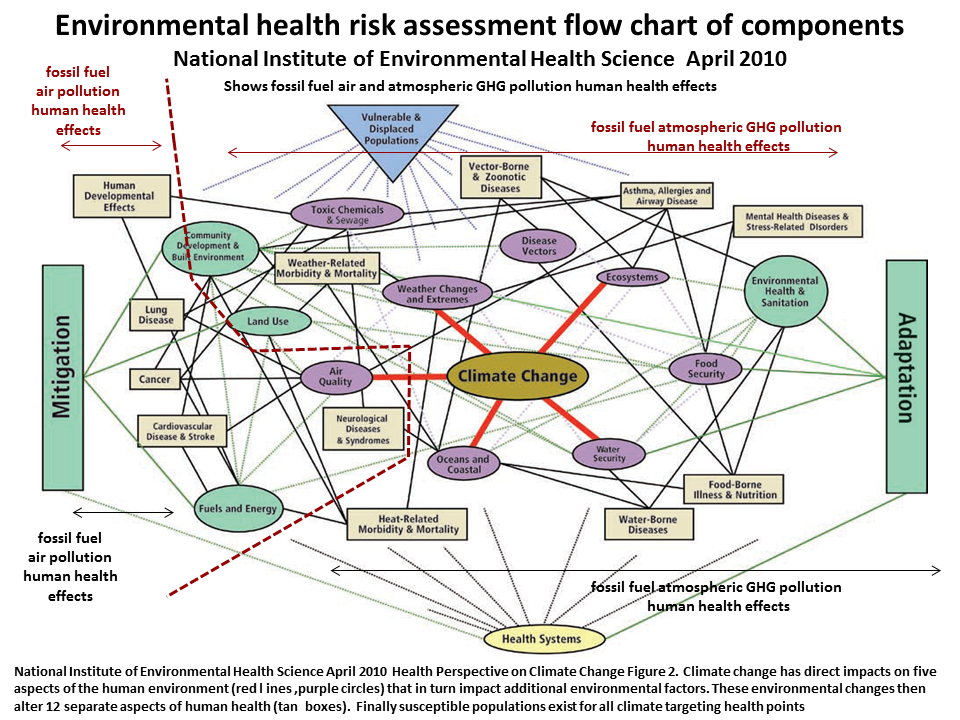

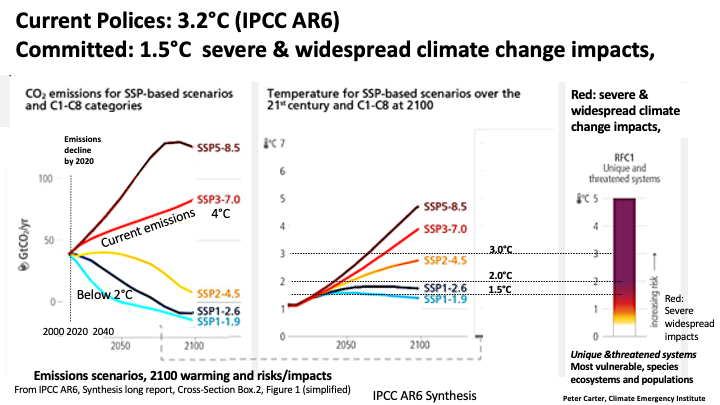


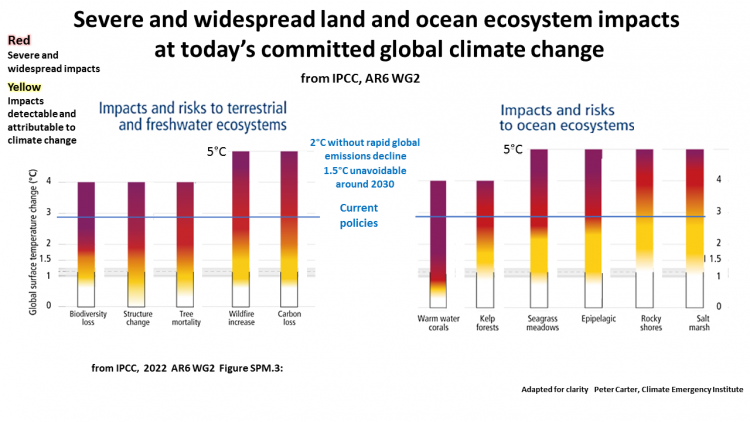
In the case of an injury, sometimes an emergency situation is obvious, and often only a careful examination looking for signs of a worst case outcome reveals an emergency response situation. The same applies to an environmental health threat.
The impacts of allowing global climate change to continue have been known for decades.
Pollution. The issue is one of pollution - sources of atmospheric greenhouse gas pollution which is the worst ever environmental health hazard. We have had many decades of experience in assessing risks of pollution.
However climate change assessments do not use a pollution risk assessment approach.
A best guide we have is the 2010 A Human Health Perspective on Climate Change published by Environmental Health Perspectives and the National Institute of Environmental Health Sciences. The flow chart (above) from the publication shows the many more essential aspects and connections of a proper environmental risk assessment that the climate change assessments.
The other essential aspect that all the environmental health science agrees with is the involvement at the start of public stakeholders.
The 2007 IPCC AR4 assessment showed clearly from all the impacts on billions of people and on future generations that 2°C is disastrous (as James Hansen has said) and that for vulnerable populations 1°C is the danger limit.
"The stated goal of the UNFCCC – avoiding dangerous anthropogenic interference in the climate – is in fact unattainable, because today we are already experiencing dangerous anthropogenic interference."
— John P. Holdren, Distinguished Scientist Seminar, 3 Nov 2006 Meeting the Climate Change Challenge.
(Dr. Holdren is US Presidential Science Advisor, Professor of Environmental Policy at Harvard University, and Former President of the American Association for the Advancement of Science)
Even so, no one has submitted that this is the case to the United Nations climate negotiations. As a result, the negotiators are not under pressure to reach an agreement and the industrialized nations are not being held accountable under international law.
Dangerous interference with the climate system refers to atmospheric greenhouse gas concentrations. The distinction between dangerous interference and dangerous climate change is most important because of the basic science of greenhouse gases in the atmosphere and how planetary systems respond to atmospheric greenhouse gas warming.
The science of global climate change is characterized by long lag times between emissions of greenhouse gases and their impact being experienced by ecosystems, species and human populations on the planet. Put simply, the cause and effect relationship between atmospheric greenhouse gases and their global warming means that at any particular time and global average temperature increase, that particular temperature increase is bound to be doubled in the future and that the increased temperature and all global climate change impacts will last for over 1000 years.
RISK MANAGEMENT AND CLIMATE CHANGE by Howard Kunreuther et al. was published in Nature 2013. It is the latest we have published by the climate science.
The Bradford Hill risk criteria (9) remain a basis of toxicology to determine causation. Climate change assessments seek cause and effect rather than causation.
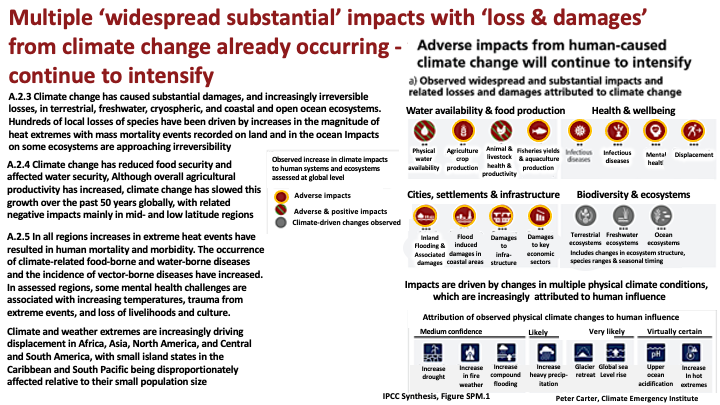
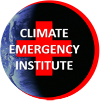
Climate change is an environmental health issue- that of all time, but it is not assessed as one, even though this is how pollution has been assessed for many years. The climate assessments are left to the IPCC. The IPCC assessment in a great many ways is not a risk assessment. It assesses for probability - not for risk. In fact the greatest impacts are excluded from the climate change projections (the large sources of amplifying feedbacks).
Risk has long been defined as the product of an impact and magnitude of the impact.
The IPCC AR6 defines Risk as 'The potential for adverse consequences for human or ecological systems, recognising the diversity of values and objectives associated with such systems', which is not risk missing the key aspect of magnitude.
Also they only go to 2100.
Since the 2001 Assessment the 'burning embers' Reasons for Concern are the way the IPCC conveys risk. These are useful but they are the projections of actual impacts. True risks that include magnitude occur at much lower degrees of warming.
The IPCC AR6 defines Risk as 'The potential for adverse consequences for human or ecological systems, recognising the diversity of values and objectives associated with such systems', which is not risk missing the key aspect of magnitude.
Also they only go to 2100.
Since the 2001 Assessment the 'burning embers' Reasons for Concern are the way the IPCC conveys risk. These are useful but they are the projections of actual impacts. True risks that include magnitude occur at much lower degrees of warming.
Reasons For Concern
RFC1 Unique & threatened systems: ecological and human systems that have restricted geographic ranges constrained by climate-related conditions and have high endemism or other distinctive properties. Examples include coral reefs, the Arctic and its Indigenous People, mountain glaciers and biodiversity hotspots.
RFC1 Unique & threatened systems: ecological and human systems that have restricted geographic ranges constrained by climate-related conditions and have high endemism or other distinctive properties. Examples include coral reefs, the Arctic and its Indigenous People, mountain glaciers and biodiversity hotspots.
RFC2 Extreme weather events: risks/impacts to human health, livelihoods, assets and ecosystems from extreme weather events such as heatwaves, heavy rain, drought and associated wildfires, and
coastal flooding.
RFC3 Distribution of impacts: risks/impacts that disproportionately affect particular groups owing to uneven distribution of physical climate change hazards,
RFC3 Distribution of impacts: risks/impacts that disproportionately affect particular groups owing to uneven distribution of physical climate change hazards,
exposure or vulnerability.
RFC4 Global aggregate impacts: impacts to socio-ecological systems that can be aggregated globally into a single metric, such as monetary damages, lives affected, species lost or ecosystem degradation at a global scale.
RFC5 Large-scale singular events: relatively large, abrupt and sometimes irreversible changes in systems
RFC4 Global aggregate impacts: impacts to socio-ecological systems that can be aggregated globally into a single metric, such as monetary damages, lives affected, species lost or ecosystem degradation at a global scale.
RFC5 Large-scale singular events: relatively large, abrupt and sometimes irreversible changes in systems
caused by global warming, such as ice sheet disintegration or thermohaline circulation slowing.
IPCC PDF of risk presentation
Environmental health risk
Global climate change is the greatest ever environmental health risk. Like other very dangerous environmental health risks the problem is POLLUTION, and over the past decades we have developed sophisticated and reliable methods to assess environmental risks for human population health
protection.